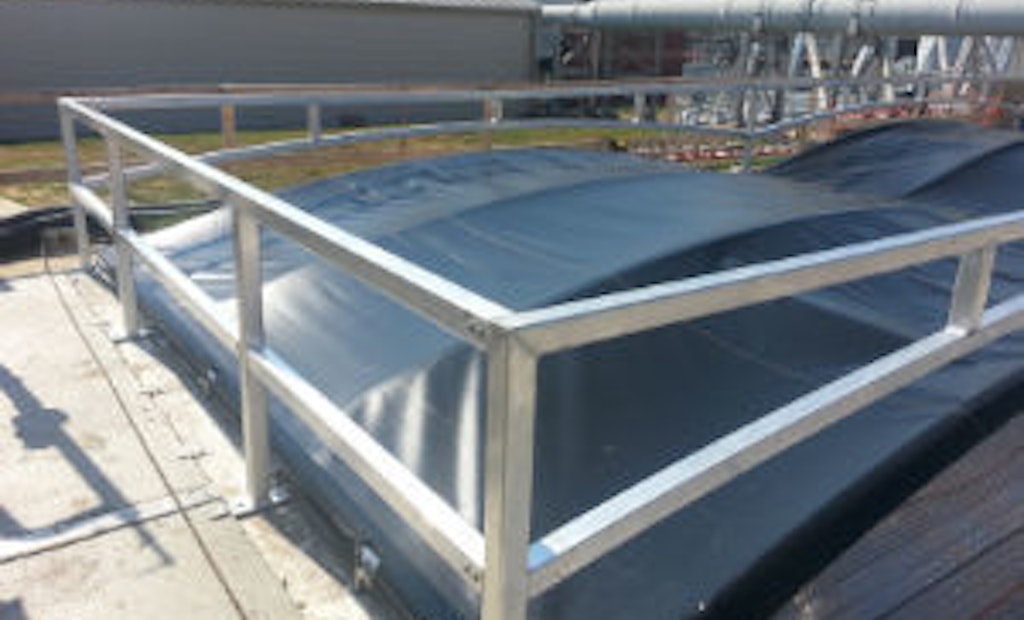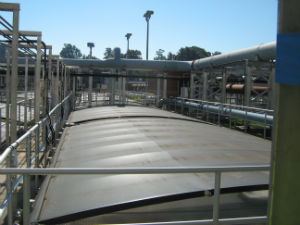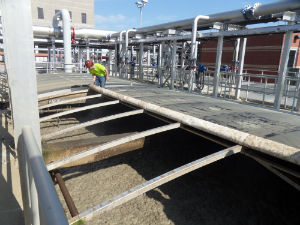
Interested in Odor Control?
Get Odor Control articles, news and videos right in your inbox! Sign up now.
Odor Control + Get Alerts
 The utility:
The utility:
The James River Treatment Plant is one of nine major treatment plants operated by the Hampton Roads Sanitation District, a subdivision of the Commonwealth of Virginia. The plant, which is located in Newport News, Virginia, is committed to protecting the environment and enhancing neighboring communities through various wastewater treatment improvements.
The plant has an average design flow of 20 mgd, a current annual average flow of 14 mgd, and permit limits of 30 mg/L BOD, 30 mg/L TSS, 2 mg/L total phosphorus, and 12 mg/L total nitrogen.
The utility’s needs:
The James River Treatment Plant is bordered on one side by the James River and by houses and a park on the other. Although the James River Treatment Plant had installed odor control systems to capture and treat foul air from parts of the plant, its conventional aeration tanks were producing low-level odors that required additional control. Surrounding residents complained.
The plant's staff investigated the complaints and worked with neighbors to identify the odor source. An air specialist at the plant took samples from various areas at the location, and even went so far as to bring sample bags to neighbors. Nocardia foam from the aeration tanks was found to be the culprit.
Plant management made a commitment to neighbors that the odors would be addressed.
The solution:
The plant retained CH2M HILL as its advisor to help solve the odor problem, and a decision was made to capture foul air under a cover system so it could be withdrawn and treated in a carbon system.
 Various covers were considered. One plan involved covering one portion of the integrated fixed-film activated sludge tanks with fixed concrete decks that would serve as both covers and mounting surfaces for the scrubbers, and covering the other portion with retractable fabric covers that would provide convenient access to the tank internals. Plant staff participating in the design process noted they needed to easily access mixers, media and the spray system within the IFAS tanks.
Various covers were considered. One plan involved covering one portion of the integrated fixed-film activated sludge tanks with fixed concrete decks that would serve as both covers and mounting surfaces for the scrubbers, and covering the other portion with retractable fabric covers that would provide convenient access to the tank internals. Plant staff participating in the design process noted they needed to easily access mixers, media and the spray system within the IFAS tanks.
Plant workers needed to inspect aeration patterns, clean out anoxic sections and get inside the tanks when required. These access requirements, along with the possibility of excessive loads that could be imposed on tank walls by concrete lids and scrubbers, led to the decision to design for an alternative scrubber location and cover the tanks entirely with retractable fabric covers instead.
CH2M HILL was aware of retractable fabric covers provided by Geomembrane Technologies Inc. (GTI) and led an investigation into their merits. GTI was eventually selected to provide the cover solution using its retractable, structurally supported covers, custom-designed to meet the plant’s specific requirements for access, equipment penetrations and rainwater management. The GTI covers consist of retractable, plastic-coated fabric panels tensioned over low-profile, arched aluminum frames.
Later, an ANITA Mox treatment system — the only one in the USA right now — was installed to extend the plant’s nutrient removal efforts. The ANITA Mox tank also required a cover for odor control, and because the tank contains mixers, media and heaters, easy accessibility was again an essential requirement.
“GTI’s structurally supported covers provided access and odor control so well on the IFAS tanks that we chose them for the ANITA Mox tank, too,” says Bob Rutherford, plant manager.
The results:
GTI’s structurally supported covers have helped the James River Treatment Plant continue to be a good neighbor to the surrounding community without hindering plant workers from effectively performing their jobs.
“The covers worked out really well,” says Rutherford.
The James River Treatment Plant was mindful to address the odor control issue aesthetically. For example, it was logical to locate the scrubbers near the covers, but it was also important to consider the neighbors’ views. Care was taken in choosing a location for the scrubbers near the tanks, but out of the neighbors’ sight. The covers are low profile and reliably control odors while still providing easy access to tank internals, which was crucial to plant staff.
Because of the proven success of the covers, the James River Treatment Plant later contacted GTI to custom-design retractable covers for its pre-aeration tanks too. The two new covers measure 20 feet by 40 feet and provide the same odor control benefits as the covers on the plant’s IFAS tanks and ANITA Mox tank.
About GTI
For more information, visit www.gticovers.com, contact covers@gticovers.com, or call 506/449-0993.





